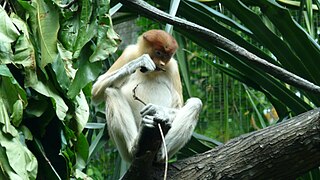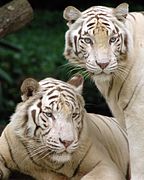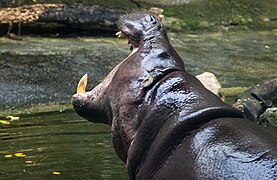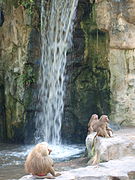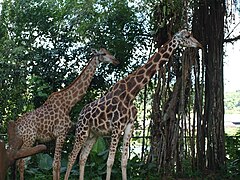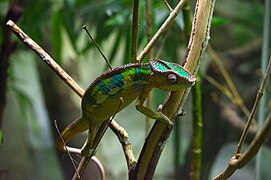bio.wikisort.org - Zoo
The Singapore Zoo, formerly known as the Singapore Zoological Gardens or Mandai Zoo, is a 28 hectares (69 acres) zoo located on the margins of Upper Seletar Reservoir within Singapore's heavily forested central catchment area. Opened in 1973, the zoo was built at a cost of $9 million that was granted by the government of Singapore.
 | |
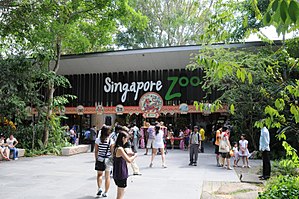 Entrance of the Singapore Zoo, 2010
 | |
| Date opened | 27 June 1973 |
|---|---|
| Location | Mandai, Singapore 80 Mandai Lake Road, Singapore 729826 |
| Coordinates | 1°24′14″N 103°47′39″E |
| Land area | 28 ha (69 acres) |
| No. of animals | 2,530 |
| No. of species | 315 |
| Annual visitors | 2,132,270 (FY 2019/20)[1] |
| Public transit access | |
| Website | Singapore Zoo |
It is operated by the Mandai Wildlife Reserve, which also manages the neighbouring Night Safari, River Wonders, the Jurong Bird Park[lower-alpha 1] as well as the forthcoming Rainforest Wild Park. All five parks makes up the Mandai Wildlife Reserve, which consists of more than 15,000 animals from 1,000 species.[2][3] Within the zoo, there are about 315 species of animals, of which some 16 percent are considered to be a threatened species. The zoo attracts over 2 million visitors every year.[1]
Singapore Zoo has always exhibited animals in naturalistic, 'open' exhibits with hidden barriers, moats, and glass between the animals and visitors. It houses the largest captive colony of orangutans in the world.[4] The Singapore Zoo has been highly ranked by various international metrics.[5]
History

Prior to the establishment of Singapore Zoo, there were other short-lived zoos in Singapore's history, including the first recorded zoo founded in the early 1870s at the present-day Singapore Botanic Gardens,[6] a zoo opened in the 1920s in Ponggol (present-day Punggol) by animal trader William Lawrence Soma Basapa and two zoos run by two brothers by the surname of Chan during the 1960s.
The conception of the Singapore Zoo dates from 1969. At the time, the Public Utilities Board (PUB) decided to use some of its land holdings around reservoirs for parks and open recreational facilities. The executive chairman of the PUB, Dr Ong Swee Law, set aside 88 ha (220 acres) of land for the construction of a zoological garden.
In 1970, consultants and staff were hired, and in 1971, the construction of the basic 50 enclosures was started. Animals were collected from dealers and donated by sponsors. The director of the National Zoological Gardens of Sri Lanka, Lyn de Alwis, was hired as a special consultant to work out the problems inherent in tropical zoos.[7]
On 27 June 1973, the Singapore Zoo opened its gates for the first time with a collection of 270 animals from over 72 species, and a staff of 130. By 1990, 1,600 animals from more than 160 species lived in social groups, housed in 65 landscaped exhibits with boundaries conceived to look as natural as possible.
In 1987, the zoo began to display rare animals loaned by other zoos. The first animals displayed in this manner were the rare golden snub-nosed monkeys from China in 1987, which attracted more than half a million visitors. This was followed by white tigers from Cincinnati Zoo in 1988 and giant pandas from Wolong National Nature Reserve in 1990.[4]
On 1 August 2000, Singapore Zoological Gardens, Jurong Bird Park and Night Safari were integrated under Wildlife Reserves Singapore, under the umbrella of Temasek Holdings. The zoo underwent a restructuring to improve its efficiency and branding which included the merging of shared services and expansion of consultancy services overseas. Night Safari, which began under the zoo, became a separate branding entity.[citation needed]
The restructuring of the zoo was not without controversy. Several key staff, including CEO Bernard Harrison, left as a result in 2002, citing differences in management style. In 2003, Wildlife Reserves Singapore launched a massive rebranding exercise, which was shelved due to widespread public disapproval. The name of the zoo was simplified to Singapore Zoo sometime by 2005.[citation needed]
As a result of the restructuring, more facilities were launched, such as a S$3.6 million Wildlife Healthcare & Research Centre in 2005. Existing infrastructure was revamped to further enhance the experience of visitors. The growth in revenue continued on an upward trend.[citation needed]
Animals and exhibits
- Treetops Trail
- Siamang
- False gharial
- Orangutan Island
Orangutans have been a major attraction of the Singapore Zoo since its opening. A female Sumatran orangutan named Ah Meng became an icon for tourism, appearing in several tourism advertisements. She hosted the 'Breakfast with Orangutans' program, where visitors were allowed to take pictures and interact with her.[8] Ah Meng died on 8 February 2008 to old age at 47 years old. Ishta, Ah Meng's granddaughter, was chosen to take over the namesake of Ah Meng.[9]
- Bornean orangutan
- Sumatran orangutan
- Wild Africa
This area houses the zoo's African savannah animals.[10]
- African lion
- African wild dog
- Cheetah
- Common ostrich
- Grévy's zebra
- Meerkat
- Nyala
- Red river hog
- Rothschild's giraffe
- Southern white rhinoceros
- Cat Country
- Fossa
- Naked mole-rat
- Sri Lankan leopard
- Reptile Garden
The outdoor portion of the zoo's reptile complex which has enclosures for the zoo's larger reptiles like giant tortoises, Komodo dragons and crocodiles.[11]
- Aldabra giant tortoise
- Gharial
- Komodo dragon
- Rhinoceros iguana
- Saltwater crocodile
- RepTopia
Opening on August 16, 2017, RepTopia was a renovation of the 35 year old Snake House. Several species of reptiles and amphibians are housed in four different regions, Deserts of the World, Indo-Pacific, Tropical Africa and Neotropical Rainforests. A behind-the-scenes facility is visible to the guests, allowing them to view the hatchery.[12]
In January 2022, thirteen Roti Island snake-necked turtles were successfully repatriated to a breeding facility in Kupang.[13]
- Crocodile monitor
- Dyeing poison dart frog
- Electric blue gecko
- Elongated tortoise
- Gaboon viper
- Golden poison frog
- Green tree python
- Henkel's leaf-tailed gecko
- King cobra
- Madagascar day gecko
- Panther chameleon
- Plumed basilisk
- Red-footed tortoise
- Reticulated python
- Roti Island snake-necked turtle
- Veiled chameleon
- Western diamondback rattlesnake
- Tortoise Shell-ter
Formerly the Critters Longhouse, which housed small mammals, the building was transformed into the Tortoise Shell-ter in 2016, housing different species of tortoises in seven enclosures, among other reptiles and birds. Each habitat is climate-controlled with special lighting, heating and humidity control.[14]
- Burmese star tortoise
- Flat-backed spider tortoise
- Indian star tortoise
- Leopard tortoise
- Ploughshare tortoise
- Radiated tortoise
- Fragile Forest
A 20,000 cubic metre biodome that houses a wide variety of tropical birds, mammals, reptiles, fish and invertebrates.[15] The area also has a butterfly house consisting of 11 butterfly species, 8 of which are native to Singapore.[16]
- Amazon milk frog
- Common tree frog
- Eclectus parrot
- Finlayson's squirrel
- Golden lion tamarin
- Great argus
- Green iguana
- Island imperial pigeon
- Large flying fox
- Lesser mouse-deer
- Linnaeus's two-toed sloth
- Long-nosed horned frog
- Malayan peacock-pheasant
- Nicobar pigeon
- Ocellate river stingray
- Pied imperial pigeon
- Pinon's imperial pigeon
- Prevost's squirrel
- Ring-tailed lemur
- Spotted whistling duck
- Toco toucan
- Western crowned pigeon
- White-faced saki
- Wonga pigeon
- Zebra dove
- The Great Rift Valley of Ethiopia
Visitors first walk through a Konso and Amharic village with several waga sculptures dotted around. A large troop of hamadryas baboons are mixed with a herd of Nubian ibexes in an enclosure recreating the rugged steppes of Ethiopia.[17]
- Hamadryas baboon
- Meerkat
- Nubian ibex
- Rock hyrax
- Serval
- Australasia
This zone features a walkthrough habitat with kangaroos and wallabies along with a cassowary enclosure at the end of the zone. Tree-kangaroos are housed indoors but are able to access an outdoor enclosure. The zoo's male tree-kangaroo named Makaia was born in 2014 at the Adelaide Zoo and orphaned at five weeks old when his mother, Kia was crushed by a falling tree branch. He made headlines after he was adopted by a yellow-footed rock wallaby.[18] Makaia arrived at the Singapore Zoo in 2016 to accompany the zoo's female tree-kangaroo, Nupela.[19] On February 4, 2020, Nupela gave birth to a male joey.[20]
Four female koalas named Paddle, Chan, Pellita and Idalia were on loan to the zoo from the Lone Pine Koala Sanctuary to celebrate Singapore's golden jubilee in April 2015 and returned to Australia in February 2016.[21]
- Eastern grey kangaroo
- Emu
- Goodfellow's tree-kangaroo
- Magpie goose
- Red-necked wallaby
- Southern cassowary
- Primate Kingdom
The Primate Kingdom consists of a large moat with several islands which house monkeys and lemurs like s, s, colobus monkeys, s and some of the only douc langurs in captivity.[22]
- Black-and-white ruffed lemur
- Black-handed spider monkey
- Black howler monkey
- De Brazza's monkey
- Eastern black-and-white colobus monkey
- Common squirrel monkey
- Cotton-top tamarin
- L'Hoest's monkey
- Red-shanked douc
- Ring-tailed lemur
- Elephants of Asia
A herd of five female Asian elephants live in a 2.47 acre (1 ha) habitat with a large pool.[23] Komali, the matriarch of the herd, is a Sri Lankan elephant, Gambir and Jati are Indian elephants and half-sisters Aprila and Intan are Sumatran elephants.
- Rainforest Kidzworld
Located at the very north of the zoo, Rainforest Kidzworld is home to many domestic animals like goats and rabbits and there are other attractions in it like a carousel and a splash pad.[24] Guests are allowed to closely interact with the animals and feed them.
- Other animals
Other animals in Singapore Zoo's collection include
- African penguin
- Asian small-clawed otter
- Buff-cheeked gibbon
- California sea lion
- Celebes crested macaque
- Chimpanzee
- Emperor tamarin
- Great white pelican
- Lowland anoa
- Malayan tiger
- North Sulawesi babirusa
- Proboscis monkey
- Pygmy hippopotamus
- Red-capped mangabey
- Red ruffed lemur
- Sun bear
- White tiger
Education and conservation
The Wildlife Healthcare & Research Centre was opened in March 2006 as part of the zoo's efforts in wildlife conservation. The centre further underscores Singapore Zoo and Night Safari's commitment to conservation research, providing the infrastructure for the parks and overseas zoological partners to better execute their research programmes. The Singapore Zoo is the first zoo in the world to breed a polar bear in the tropics. Inuka was born on 26 December 1990, died 25 April 2018 (aged 27).
Animal activist and conservationist known as Steve Irwin admired the Singapore Zoo greatly, adopting it as the 'sister zoo' to Australia Zoo. He was at the Singapore Zoo in 2006 to officiate the opening of the Australian Outback exhibit.[25]
Shows
"Breakfast with an Orangutan" allows visitors to meet and interact closely with the orangutans in the zoo, which has included Ah Meng (died on 8 February 2008) who was an icon of the Singapore tourism industry. Animal shows, as well as token feedings coupled with live commentaries by keepers, are also the daily staple in Singapore Zoo.
The "Rainforest Fights Back" show is housed in the Shaw Amphitheatre, the main amphitheater in the zoo. Actors and performers act alongside the animals: in-show, a villainous poacher attempts to mow down a section of tropical rainforest for land development, and is foiled by the native people and the animals of the rainforest — orangutans, lemurs, peacocks, otters and cockatiels.
The "Elephants at Work and Play" show demonstrates how elephants are used as beasts of burden in south-east Asian countries. The animal caretakers are referred to as mahouts, and the show simulates how a mahout would instruct an elephant to transport logs or kneel so that they can be mounted. As of 2018, the show has been reworked as part of a shift in the care for the elephants to feature their natural behaviour instead of performing stunts.[26]
The "Splash Safari" show features the zoo's sea lions performing acts relating to their natural behaviors, and also playing frisbee with a lucky visitor.
The "Animal Friends" show, housed in the Kidzworld amphitheatre in the zoo's children's section, features mostly domesticated animals such as dogs and parrots performing tricks with the aim of teaching young children about pet responsibility.
Organising events
There are three events venues in the zoo: Forest Lodge, Pavilion-By-the-Lake and Garden Pavilion. There are also three cocktail venues: Elephants of Asia, Tiger Trek and Treetops Trail. The Singapore Zoo also caters for birthday parties and weddings.
Incidents
On 7 March 1973, a black panther escaped from the zoo before it had opened.[27]
In early 1974, a hippopotamus named Congo escaped from the zoo and spent 47 days in the Seletar Reservoir.[28]
Other escapes in 1974 included an eland and a tiger.[29]
On 13 November 2008, two Bengal white tigers mauled a cleaner, 32-year old Nordin Montong to death after he jumped into a moat surrounding their enclosure and taunted the animals.[30]
Awards
This section needs to be updated. (March 2019) |
Awarded to Singapore Zoo:[31]
- Travellers' Choice Awards - Top 3 Zoos in the World, 2018
- Singapore Tourism Awards, 2017
- Traveller's Choice Awards - Zoos and Aquariums, 2017, 2015 and 2014
- Best Customer Service (Retail) Award, 2014
- Meritorious Defence Partner Award, 2013
- Singapore Experience Awards, 2013
- Singapore Service Award, 2013
- Singapore Service Excellence Medallion - Organisation, 2013
- Meritorious Defence Partner Award, 2012
- Most Popular Wildlife Park, Asian Attractions Awards, 2011
- Michelin 3-star rating, 2008
- Best Breakfast, 40 Jewels in ASEAN's Crown, 2007
- One of the World's Best Zoos, forbes-travel.com, 2007
- Bronze, Singapore H.E.A.L.T.H Awards, 2004
- Leisure Attraction of the Year, 6th, 7th, 8th, 13th, 16th, 17th, 20th and 22nd Singapore Tourism Board Awards
- Best New Attraction for the hamadryas baboons exhibit, ASEAN Tourism Association, 2002
- Cleanest Toilet, Ministry of Environment, 1997 and 1998
Gallery
- Proboscis monkey
- False gharial
- Asian small-clawed otter
- White tigers
- Pygmy hippo
- Bornean orangutan
- Sun bear
- Dalmatian pelican
- Hamadryas baboon
- White rhinoceros
- Giraffe
- Aldabra giant tortoise
- Estuarine crocodile
- Ring-tailed lemur
- Cotton-top tamarin
- Eastern black-and-white colobus
- Red-shanked douc
- Panther chameleon
- Sri Lankan leopard
- Large flying fox
Transportation
Public transportation
Two public bus services, 138 and 927, call at the bus stop near to the Zoo.[32] 138 connects with the nearest MRT station at Springleaf as well as Ang Mo Kio station, while 927 connects with Choa Chu Kang station.
Bus
A shuttle service, known as the Mandai Khatib Shuttle, plies daily between Khatib MRT station and the Zoo. A one-way trip cost $1 for everyone above the age of three.[33][34] A separate service, known as the Mandai Express, operates on weekends and holidays to and from three locations in Bedok, Sengkang, and Tampines. A one-way trip cost between $1 and $3 for everyone above the age of three.[35][36]
Notes
- Jurong Bird Park is expected to be renamed "Bird Paradise" or "Mandai Bird Park" when it is moved and consolidated to Mandai sometime in 2023.
References
- "WRS Yearbook 2018/2019" (PDF). Wildlife Reserves Singapore.
- "Mandai Wildlife Reserve". www.mandai.com. Retrieved 11 April 2022.
- Shafeeq, Syarafana (13 October 2021). "Two wildlife parks in Mandai could be further delayed due to COVID-19; River Safari to get new name". www.straitstimes.com. Retrieved 11 April 2022.
- Catharine E. Bell (January 2001). Encyclopedia of the World's Zoos. Taylor & Francis. p. 1155. ISBN 978-1-57958-174-9.
- Chong, Clara (31 August 2017). "Singapore's zoo ranked No. 4 in the world, best in Asia on TripAdvisor". www.straitstimes.com. Retrieved 11 April 2022.
- "Fortnight's summary". The Straits Times. 5 March 1870.
- Vernon N. Kisling (18 September 2000). Zoo and Aquarium History: Ancient Animal Collections to Zoological Gardens. CRC Press. p. 233. ISBN 978-1-4200-3924-5.
- "Orangutan - Singapore Zoo". mandai.com.
- "Granddaughter of late Ah Meng named the new face of Singapore Zoo". The Straits Times. 26 February 2016.
- "Fossas, Madagascar's Apex Predators Arrive At The Singapore Zoo". littledayout.com.
- "Reptile Garden - Singapore Zoo". mandai.com.
- "RepTopia - Singapore Zoo". mandai.com.
- "First ever repatriation of critically endangered Roti Snake-necked Turtles from Singapore to their native country, Indonesia". mandai.com.
- "Tortoise Shell-ter - Singapore Zoo". mandai.com.
- "Fragile Forest - Singapore Zoo". mandai.com.
- "Press Room - Flurry of wings at Singapore Zoo's Fragile Forest". mandai.com.
- "Great Rift Valley of Ethiopia - Singapore Zoo". mandai.com.
- "Adelaide Zoo farewells Makaia, our miracle tree kangaroo". adelaidezoo.com.au.
- "'Miracle' tree kangaroo moves to Singapore Zoo". straitstimes.com.
- "Australia's famous endangered Goodfellow's tree-kangaroo becomes a dad". kidsnews.com.au.
- "Koalas ready to welcome visitors at Singapore Zoo". travelmail.in.
- "Primate Kingdom - Singapore Zoo". mandai.com.
- "Elephants of Asia - Singapore Zoo". mandai.com.
- "Rainforest Kidzworld - Singapore Zoo". mandai.com.
- "Remembering Steve Irwin" (PDF). Wildlife Reserves Singapore. Archived (PDF) from the original on 11 March 2014. Retrieved 22 July 2013.
- "Elephants no longer made to perform at Singapore Zoo". straitstimes.com.
- "Headlines that shook Singapore (since 1955)". Remember Singapore. 24 January 2011. Archived from the original on 20 March 2014. Retrieved 21 March 2014.
- "Flashback: 40 Years of The Singapore Zoo". The Straits Times. 2013. Archived from the original on 16 June 2015.
- "Bernard Harrison interview (part 2)". The Independent Singapore. 20 September 2013. Archived from the original on 27 February 2014.
- "White tigers maul man to death in Singapore zoo". 13 November 2008 – via reuters.com.
- "About Singapore Zoo". wrs.com.sg. Archived from the original on 22 March 2019. Retrieved 31 March 2019.
- "Getting here". wrs.com.sg.
- "Getting here - Mandai Khatib Shuttle". wrs.com.sg.
- Chew, Hui Min (9 March 2017). "New daily express bus from Khatib to Mandai wildlife parks". The Straits Times. Retrieved 9 March 2017.
- "Getting here - Mandai Express". wrs.com.sg.
- "Mandai Express". form.jotform.com.
Bibliography
- Véronique Sanson (1992). Gardens and Parks of Singapore. Oxford University Press. ISBN 0-19-588588-0
- Ilsa Sharp (1994). The First 21 Years: The Singapore Zoological Gardens Story. Singapore Zoological Gardens. ISBN 981-00-5674-5
External links
 Geographic data related to Singapore Zoo at OpenStreetMap
Geographic data related to Singapore Zoo at OpenStreetMap- Official website
- Map of Singapore Zoo
- Singapore Zoo on the Singapore Government National Library Board
- Singapore Zoo Guide
Другой контент может иметь иную лицензию. Перед использованием материалов сайта WikiSort.org внимательно изучите правила лицензирования конкретных элементов наполнения сайта.
WikiSort.org - проект по пересортировке и дополнению контента Википедии
